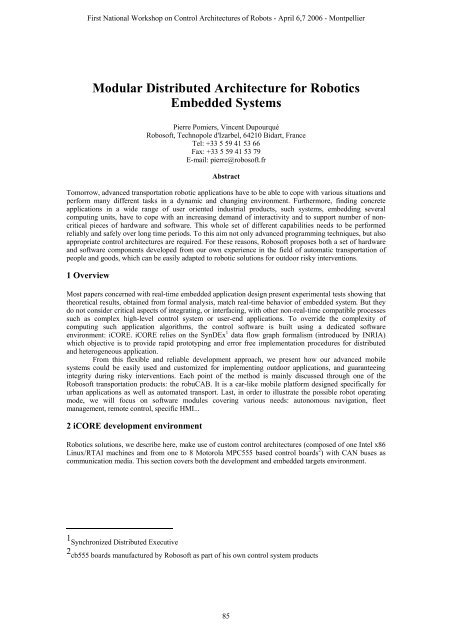Pleading for open modular architectures - Lirmm
Pleading for open modular architectures - Lirmm
Pleading for open modular architectures - Lirmm
Create successful ePaper yourself
Turn your PDF publications into a flip-book with our unique Google optimized e-Paper software.
First National Workshop on Control Architectures of Robots - April 6,7 2006 - Montpellier<br />
Modular Distributed Architecture <strong>for</strong> Robotics<br />
Embedded Systems<br />
Pierre Pomiers, Vincent Dupourqué<br />
Robosoft, Technopole d'Izarbel, 64210 Bidart, France<br />
Tel: +33 5 59 41 53 66<br />
Fax: +33 5 59 41 53 79<br />
E-mail: pierre@robosoft.fr<br />
Abstract<br />
Tomorrow, advanced transportation robotic applications have to be able to cope with various situations and<br />
per<strong>for</strong>m many different tasks in a dynamic and changing environment. Furthermore, finding concrete<br />
applications in a wide range of user oriented industrial products, such systems, embedding several<br />
computing units, have to cope with an increasing demand of interactivity and to support number of noncritical<br />
pieces of hardware and software. This whole set of different capabilities needs to be per<strong>for</strong>med<br />
reliably and safely over long time periods. To this aim not only advanced programming techniques, but also<br />
appropriate control <strong>architectures</strong> are required. For these reasons, Robosoft proposes both a set of hardware<br />
and software components developed from our own experience in the field of automatic transportation of<br />
people and goods, which can be easily adapted to robotic solutions <strong>for</strong> outdoor risky interventions.<br />
1 Overview<br />
Most papers concerned with real-time embedded application design present experimental tests showing that<br />
theoretical results, obtained from <strong>for</strong>mal analysis, match real-time behavior of embedded system. But they<br />
do not consider critical aspects of integrating, or interfacing, with other non-real-time compatible processes<br />
such as complex high-level control system or user-end applications. To override the complexity of<br />
computing such application algorithms, the control software is built using a dedicated software<br />
environment: iCORE. iCORE relies on the SynDEx 1 data flow graph <strong>for</strong>malism (introduced by INRIA)<br />
which objective is to provide rapid prototyping and error free implementation procedures <strong>for</strong> distributed<br />
and heterogeneous application.<br />
From this flexible and reliable development approach, we present how our advanced mobile<br />
systems could be easily used and customized <strong>for</strong> implementing outdoor applications, and guaranteeing<br />
integrity during risky interventions. Each point of the method is mainly discussed through one of the<br />
Robosoft transportation products: the robuCAB. It is a car-like mobile plat<strong>for</strong>m designed specifically <strong>for</strong><br />
urban applications as well as automated transport. Last, in order to illustrate the possible robot operating<br />
mode, we will focus on software modules covering various needs: autonomous navigation, fleet<br />
management, remote control, specific HMI...<br />
2 iCORE development environment<br />
Robotics solutions, we describe here, make use of custom control <strong>architectures</strong> (composed of one Intel x86<br />
Linux/RTAI machines and from one to 8 Motorola MPC555 based control boards 2 ) with CAN buses as<br />
communication media. This section covers both the development and embedded targets environment.<br />
1 Synchronized Distributed Executive<br />
2 cb555 boards manufactured by Robosoft as part of his own control system products<br />
85

















